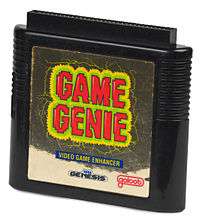Cheat cartridge

A cheat cartridge is a device that connects to any sort of cartridge-based video game system. It allows a user to input special cheat codes to manipulate a game in a way not permitted by its original programming. Usually the effect is to gain infinite lives, ammunition, unlock secrets, or do things that would otherwise allow an unfair advantage (or disadvantage in some cases). Some games have codes to activate unreleased levels, weapons, or items that may not have been available normally, and some even have codes to access debug menus used by programmers (as for beta testing purposes). Equivalent non-cartridge devices have been released and sold for modern game systems that use optical media instead of cartridges to store games.
Functions
A cheat cartridge's operation is simple. When powered on, the console will run the software stored on the cheat device. This is usually a menu from which the correct game is selected, and various cheats toggled on or off. When the user is ready, the device's software then runs the actual game. However, the activated cheats modify values in the game's code as it runs, producing the desired effects, such as infinite lives and ammunition.
For cartridge-based systems, typically the device connects to the same port as normal game cartridges, thus allowing it to be plugged into the console's game slot. The game to be cheated is then attached to the device itself using another identical port. The cheat cartridge is then "in-between" any communication between the cartridge and the console, allowing it to modify the game to achieve the desired effect.
On systems which do not use cartridges, the cheat software is loaded from a "boot disk". After selecting the correct cheats, the user exchanges the boot disk for their own game disk without resetting the console. The cheat software then launches the game and a trainer, a piece of software that stays in the system's memory and modifies the data to achieve the desired cheat effects.
In a few instances, now largely historical, the cheat cartridge operated by connecting through an expansion port, serial port, or developer interface on the console. The cartridge then exploited weakness in the device's low-level operating system to launch its own software and modify values in the system's memory. Although these are a minority, the low-level access they provided - akin to a hardware debugger - allowed the greatest level of control over the game system.
The original Action Replay cartridge for the Commodore 64, for example, exploited weaknesses presented by a backwards compatibility mode intended for the obscure Commodore MAX Machine. Electronics in the cartridge would briefly stop the console's CPU and direct it to operate on instructions in the cheat cartridge's ROM, in its own bank of RAM memory. As the computer's own RAM was no longer being modified, the game was "frozen" in its current state. That state could then be modified, saved, or reloaded to an earlier state, giving the cartridge its name. When the player was ready, the game was unfrozen, and the CPU picked up where it had left off, operating on instructions in the computer's own memory.